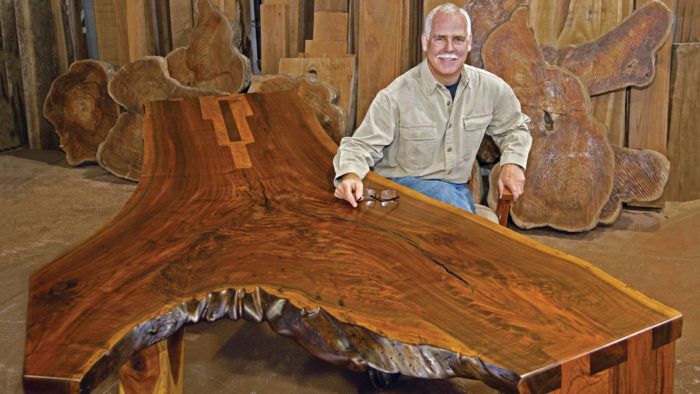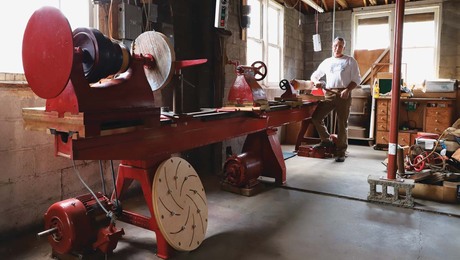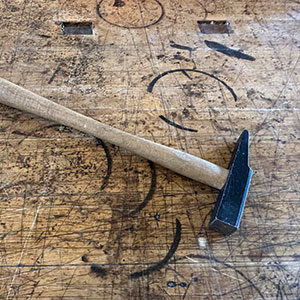From the bench: Woodworker to entrepreneur, and back again
After a career as a commercial furniture designer and maker, the man who brought Gorilla Glue to the U.S. market finds fulfillment again as a simple woodworker.
Synopsis: After a career as a commercial furniture designer and maker, the man who brought Gorilla Glue to the U.S. market finds fulfillment again as a simple woodworker.
For nearly 60 years, I have been designing, shaping, and crafting furniture. My journey has taken some interesting twists and turns, from framing tract homes, working for Knoll International, and founding my company Giati Designs, to creating the brand, product, and company known as Gorilla Glue. Most recently I have come full circle back to where I started: two hands, a piece of wood, and trying to make things that are beautiful and functional.
As I grew up in California, my father had a small hobbyist woodshop in our basement, so at about age 10, I began woodworking. Like many, I took shop class throughout junior high and high school. I also learned from wood turner Bob Stocksdale and spent two years working for Sam Maloof, a huge influence on my life. At 15-1⁄2 I left home, working summers as a carpenter, dropping out of college, and getting my journeyman’s union carpenter license in 1972.
Early on, I believed that if I designed a beautiful piece of furniture, naturally it would be sought after, manufactured, marketed, and sold by a company like Knoll, Herman Miller, Thonet, or Steelcase. I tried for years to break into the furniture design business, and I had a lot of doors closed in my face. I was naive in thinking that craftsmanship was all it took. I submitted drawings, photos, models, and prototypes to countless companies. I traveled to headquarters and met with design directors. On more than one occasion I actually walked the streets of Manhattan carrying a wooden chair on my back. Eventually one of my prototypes came together in a way that helped me break through and get my furniture commercially produced. One success led to another, as it does.
The birth of Gorilla Glue
In 1986, after having worked on the East Coast for about a dozen years, I returned to California and set up shop in Santa Barbara. In 1991, I founded Giati Designs for the purpose of having my high-end teak outdoor furniture manufactured and sold. At the time, Indonesia was one of the only sources for plantation-grown certified teak. Teak is a particularly difficult wood: The resin dulls cutting tools, and the oil in the wood makes it tough to glue. And for outdoor use gluing it is even more challenging.
I needed a better glue. I learned that a form of moisture-cured polyurethane glue was being developed to replace epoxy for environmental reasons. I first ran across this new type of glue at a small factory in Bandung, West Java. It didn’t work well. About a year later, our factory in East Java showed me another moisture-cured polyurethane glue made by a small Danish company. It was pretty good, so I asked if they could make some changes to the product. Then I acquired the rights for North America and other territories.
I came up with the name, drew up the logo, and Gorilla Glue was born.
Back to the heart of things
As the years passed, although I never stopped designing and making furniture, I wanted to experience again the joy of working wood full time. So I sold Gorilla Glue to a wonderful family in Cincinnati. Through their hard work, the business has grown nearly a hundred-fold.
Only recently do I feel that I have finally found my voice as a woodworker. I’m enjoying the luxury of living to work, instead of working to live, and the continued joy I find in exploring what wood can do.
Some time ago, a book of stories arrived in the mail. The author, Mark Singer, is a woodworker, metalworker, inventor, production furniture designer, owner of several companies, and the entrepreneur who brought Gorilla Glue to the United States. The book he sent us, Heartwood: Lessons Learned During a Lifetime Working with Wood, was written as a portfolio of his work, but grew to include reflections on his career for his children to read. Presented here are a few snippets of his story.
Mark Singer is founder of Giati Designs in Carpinteria, Calif.
From Fine Woodworking #286





















Comments
People are so interesting. I myself find the draw at 51 to simplify. There's a point at which, I think, you begin to notice that you can go so fast that everything is blurry. It's only when you stop or slow down that you can start to see things with clarity.
Log in or create an account to post a comment.
Sign up Log in